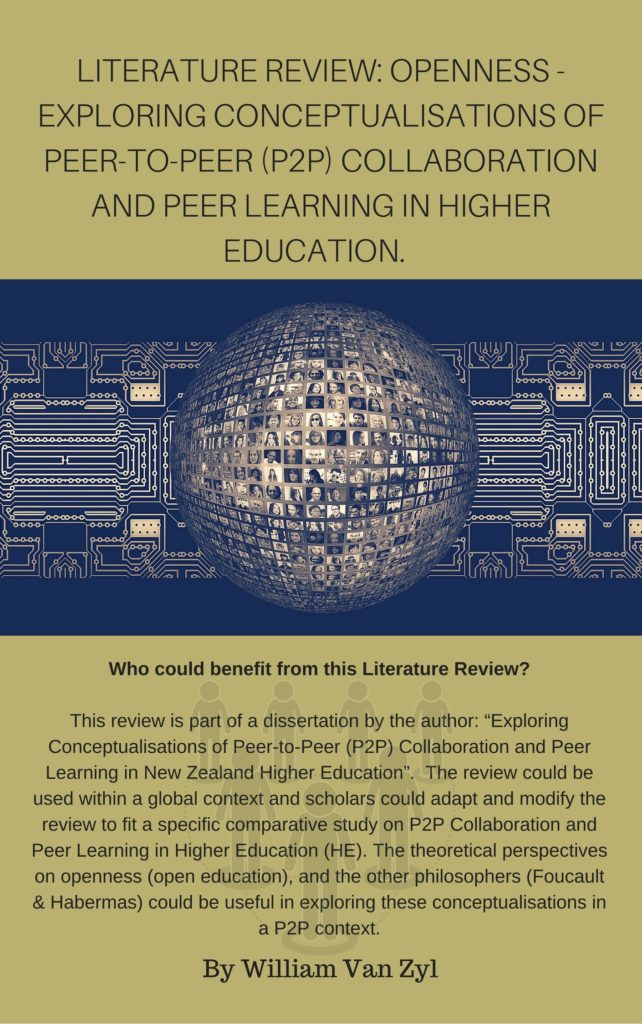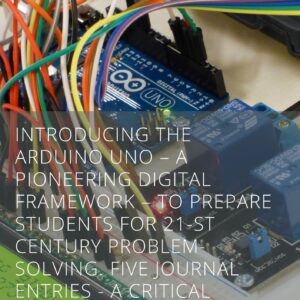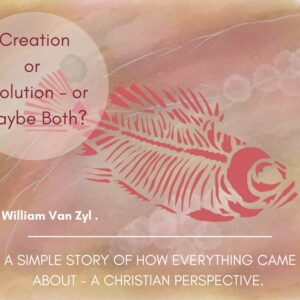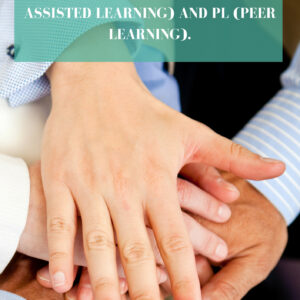Original price was: $3.99.$2.99Current price is: $2.99.
WORD COUNT: 15,000 words (129 pages size A4 -font size P 12). APA Reference style.
The relevance of this literature to researchers
This literature review could be useful to scholars researching topics on P2P collaboration and other P2P related areas of interest. It provides the groundwork and basic premises for P2P related research. It also provides an introduction to the philosophical theories of Bergson, Popper, Soros, Foucault and Habermas within a P2P, and open society (knowledge economy) context.
Who could benefit from this Literature Review?
Graduate and postgraduate students could find this review useful.
Glossary and Abbreviations
Higher Education – HE
Peer-to-Peer (collaboration) – P2P
Peer Learning – PL
Peer Assisted Learning – PAL
Open Education – OE
Open Education Resource – OER
New Zealand – NZ
Open Society – OS
Student-centered learning – SCL
Prosumer Innovation – PI
Collective Intelligence – CI
Global Citizens – GC
Open Access – OA
Artificial Intelligence –AI
Intelligent Web – IW
Background to the Literature Review:
This review is part of a dissertation by the author (2016) with the title “Exploring Conceptualisations of Peer-to-Peer (P2P) Collaboration and Peer Learning in New Zealand Higher Education”. The review could be used within a global context and scholars could adapt and modify the review to fit a specific comparative study on P2P Collaboration and Peer Learning in Higher Education (HE). The theoretical perspectives on openness (open education-theorist Popper), and the other philosophers (Foucault & Habermas) could be useful in exploring these conceptualisations in a P2P context.
Biopower and Communicative action (theories):
‘Openness’ and the concept of ‘neoliberalism’ in the two main philosophical theories of Michel Foucault on Governmentality (‘biopower’) and Jürgen Habermas on Communicative Action are at the heart of the ‘democratisation of the knowledge economy’ debate. There is no point of convergence when comparing the theory of Foucault and Habermas. Foucault is mainly concerned with providing a genealogical account of the diffusion of power (political & economical), whereas Habermas is concerned with creating a political philosophy based on the recognition of the communicative capacities of rational human beings, which Foucault neglects. I reason that openness and collaborative networks for teaching and learning are powerful tools for HE in NZ if it is ‘free’ (or low cost) and open.
Description
ABSTRACT:
Concepts of ‘openness’ in education hinge on interactions between individuals and organisations and boundaries within which these interactions exist. The future development of Peer-to-Peer (P2P) technologies in Higher Education rests on the critical decisions of ‘openness’ (‘open’ & ‘free’ education). The conceptualisations are largely influenced by those responsible for making political, economic and social decisions. I argue that NZ is currently in a favourable position to take advantage of P2P technologies because it has the basic infrastructure to support collaborative technologies (digital interconnectivity-Web 2.0 moving into Web 3.0). This literature review explores the value of philosophical perspectives or ‘foundational schools of thought on openness’ from theorists such as Karl Popper, Michel Foucault, and Jürgen Habermas – which act as a measuring stick in this literature review to gauge the position of NZ HE’s ‘open’ education within a global tertiary education context.
‘Openness’ and the concept of ‘neoliberalism’ in the two main philosophical theories of Michel Foucault on Governmentality (‘biopower’) and Jürgen Habermas on Communicative Action are at the heart of the ‘democratisation of the knowledge economy’ debate. There is no point of convergence when comparing the theory of Foucault and Habermas. Foucault is mainly concerned with providing a genealogical account of the diffusion of power (political & economic), whereas Habermas is concerned with creating a political philosophy based on the recognition of the communicative capacities of rational human beings. Foucault neglects this notion of Habermas. I reason that openness and collaborative networks for teaching and learning are powerful tools for HE in NZ if it is ‘free’ (or low cost) and open. NZ has been part of a neoliberal ‘experiment’ (1980 to the 1990s) where political, economic and social structures were reformed. NZ was influenced by ‘Reaganism (USA)’ and ‘Thatcherism (UK)’ – these are Neoliberal approaches which include elements of ‘free market’ principles, privatisation and minimum interference with the private sector (individualistic concepts).
P2P technologies implemented by some OECD countries compared to NZ (New Zealand) shows that NZ HE (Higher Education) is utilising and implementing P2P technologies (VLE’s, video, podcasts, vodcasts, microblogging, and Moodle) successfully and effectively to enhance peer teaching and learning. I reason, with specific reference to the fundamental notion of the ‘openness school of thought’, that the P2P learning and teaching technologies in NZ HE are well developed, and NZ takes every opportunity to develop and refine the infrastructure and software available.
The Neoliberalist (‘laissez fair’) approach refers to an economic system in which transactions between private parties are free from government interference, such as regulations, privileges, tariffs, and subsidies (Peters, 2011; Olsen & Peters, 2005). I reason that this approach in HE shows agendas seeking profit over altruism. The paradigm of education as a ‘social good’ within the knowledge economy (knowledge to be shared) is at the heart of the philosophical approach in this paper. Peters (2011) suggests that what is required is a change in ‘ethos’. “It is not the confidence and trust of the markets but rather the development of trust that comes with the radically decentered democratic collaboration that epitomises distributed knowledge, political and energy systems” (Peters, 2011, p.182).
It is clear in that NZ HE tertiary institutions are becoming more ‘open’ through sharing resources, for example, the Research Commons (Waikato University), nzresearch.org.nz, OpenDOAR (Authoritative Directory of Academic Open Access Repositories), and ROAR (Global Registry of Open Access Repositories), and other.
I also show how indigenous Māori culture (New Zealand context) embraces concepts of ako [reciprocal learning/teaching [ and Te Whāriki [‘a woven mat for all to stand on’] which is illuminated in social media (Twitter), as an empowering platform for connected learning. The P2P networks within a collaborative digital ‘communicative’ framework provide the ‘woven mat of co-created experiences and knowledge’ (devolved-communicative action principle) as an alternative to a neoliberalist approach (‘Reaganism/Reaganomics & Thatcherism’). Finally, it is recommended that a ‘community’ paradigm and the reinstitution of the ‘welfare state’ (education for the good of all), away from the current ‘individualistic’ approach where the wealth (and knowledge) does not trickle down to the large ‘base’ section (typical pyramid hierarchy) of society, be established. I agree with a rollback of the neoliberal state to a ‘welfare state’ as experienced in NZ before 1980 neoliberal reforms/experiments (Peters, 2011). From the second (interactionist) perspective, I reason that knowledge is socially constructed through shared understandings (‘communicative action’ – Habermas). This process could contribute to a better understanding of NZ HE’s conceptualisation of P2P technologies to promote openness.
Conclusion:
The real value of openness, “…open source, open access, and open development, is that it enables people to work together to solve common problems” (Peters, Besley & Araya, 2014, p.284). Openness in HE inaugurates a new era of social development and production. ‘P2P technologies of openness’, within an HE context, promotes and enhance the development of “social labour”, “social media”, and “social production” (Peters, Besley and Araya, 2014). I have argued how Popper, laying the foundation for openness, on which Foucault and Habermas’ theories build in this paper, opposes the inevitable and deterministic pattern of history. According to Popper (1966), it is the democratic responsibility of everyone to make a free contribution to the evolutionary process of society. Hence, transparency and trust are the keys to this ‘ethos’.
Keywords:
Peer-to-Peer Collaboration (P2P), Peer Learning (PL), Peer Assisted Learning (PAL), Openness, Neoliberalism, Post-Neoliberalism, Higher Education (HE), New Zealand (NZ), Conceptualisation, Governmentality & Biopower (Foucault), Communicative Action (Habermas), Microblogging, Twitter, and P2P Technologies.
APA citation:
Van Zyl (2016)
APA referencing:
Van Zyl, W. (2016). Literature Review: Openness – Exploring Conceptualisations of Peer-to-Peer (P2P) Collaboration and Peer Learning in Higher Education. Published to five House Publishing. Published in 2018: https://fivehousepublishing.com/product/literature-review-openness-exploring-conceptualisations-of-peer-to-peer-p2p-collaboration-and-peer-learning-in-higher-education/
Table of Contents
Literature Review: Openness – Exploring Conceptualisations of
Peer-to-Peer (P2P) Collaboration and Peer Learning in Higher
Education. 4
Abstract: 4
Concepts of ‘openness’ in education hinge on interactions between individuals and organisations and boundaries within which these interactions exist. The future development of Peer-to-Peer (P2P) technologies of Higher Education rests on the critical decisions of ‘openness’ (‘open’ & ‘free’ education). The conceptualisations are largely influenced by those responsible for making political, economic and social decisions. I argue that NZ is currently in a favourable position to take advantage of P2P technologies because it has the basic infrastructure to support collaborative technologies (digital interconnectivity-Web 2.0 moving into Web 3.0). This literature review explores the value of philosophical perspectives or ‘foundational schools of thought on openness’ from theorists such as Karl Popper, Michel Foucault, and Jürgen Habermas – which act as a measuring stick in this thesis to gauge the position of NZ HE’s ‘open’ education within a global tertiary education context. 4
Keywords: Page 8
Glossary and Abbreviations P 9
-
Collaboration and P2P networks P 15
1.1 What is P2P – Page 15
1.2 The Semantic Web, Web 1.0, Web 2.0, and Web 3.0 15
1.3 Henri Bergson, Karl Popper and George Soros on ‘free will’ and the Open Society 24
1.4 P2P collaboration, and the disadvantages of P2P collaboration, PAL and PL 29
1.5 Comments below on disadvantages listed from no. 1 to 6 by W van Zyl – referring to Table 4 (Topping & Ehly, 1998): 32
Disadvantage no. 1: Build time into PAL courses and tutoring 32
Disadvantage no. 2: Monitor PAL and P2P closely and give feedback as soon as possible 32
Disadvantage no. 3: The ‘range and depth’ of PAL and P2P teaching and learning 33
Disadvantage no. 4: Close monitoring of PAL and P2P and the rapid changes required by tutors to keep learning and teaching on track 34
Disadvantage no. 5: Ethical concerns: accountability, peer competence, and informed consent regarding PAL and P2P courses 34
Disadvantage no. 6: General misconceptions: No equal opportunities; students are not teachers; not effective for all groups (e.g. gifted and talented, students with learning difficulties, physically disabled students, and other categories). 36
1.6 Openness and New Zealand Higher Education; the focus of the literature review 36
1.7 The Intelligent Web (IW) and Artificial Intelligence (AI) 38
2.0 Openness: Prosumer engagement in Peer-to-Peer collaboration and Peer Learning (PL). 40
2.1 P2P Collaboration and PL in the Knowledge Economy 41
2.2 A short historical overview on Neoliberalism (‘Reaganism’ & ‘Thatcherism’) and the New Zealand ‘Neoliberal Experiment’ (1980 to 1990) 44
2.3 Education generations in higher education: Education 1.0, Education 2.0 and Education 3.0 46
2.4 The industrial revolution as an analogy of prosumer production 51
2.5 The three vital aspects of the P2P collaboration process and the four levels of P2P 52
The four levels of the P2P collaboration process (Bauwens, 2014) 52
2.6 Prosumer innovation: The free and open knowledge economy 58
2.7 Benkler and commons-based peer production: The ‘Wealth of Networks’. 59
2.8 Some examples of new terminology, and methods of engagement within the collaborative knowledge economy 62
2.9 The future of Artificial Intelligence (AI) and Web 3.0 technologies in PAL, PL and P2P collaboration in HE 64
2.10 Democratising innovation and the encouragement of prosumer innovation 66
2.11 Sharing and control in networks and social media platforms 67
2.12 Global efforts to provide a fair and open education landscape, the United Nations 68
-
Philosophical Perspectives and P2P Technologies: Jeremy Bentham’s penitentiary concept and P2P networks 69
3.1 Foucault, biopower [also called neoliberalism] and the role of the state in P2P networks 71
3.2 Habermas, critical theorist, on communicative action and P2P collaboration 74
-
Pedagogy 2.0 in HE teaching and learning 76
-
The relevance of this literature to researchers 79
-
Conclusion 79
-
References 81
-
APA Referencing (Author) – Page 98
-
About the researcher – Page 99


Foucault (theorist) and ‘Biopower’ (panopticon concept):
![]()
Above image: Presidio Modelo prison, inside one of the buildings, 2005. The deserted prison, designed with the idea of a panopticon in mind, is located in Cuba. Source: “Presidio-modelo2” by I. Friman. Source: https://commons.wikimedia.org/wiki/File:Presidio-modelo2.JPG#/media/File:Presidio-modelo2.JPG
Referring to the panopticon concept the philosophy of Foucault (1977) opposes this ‘system’ of society. Applied to a P2P perspective, he calls for reciprocal observation, transparency, and the sharing of power. It suggests a top to bottom and bottom to top transparency of the typical hierarchical pyramid of power. Reciprocal transparency, openness and scrutiny are the cornerstone within such a system (Peters, 2011). The notion is that P2P networks and power structures, by being combined and generalised, attain a level at which the formation of knowledge and the increase in power regularly reinforce one another in a circular process (Foucault, 1977). This component of trust has to be communicated and negotiated into P2P structures. The population engaging in the P2P activities and technologies are to ensure that authentic, transparent, and trustworthy networks are established, and the sharing of knowledge is maintained including the protection of privacy (Peters, Besley, & Araya, 2014). It is critical that all parties involved feel protected and valued.
Popper, Bergson and Soros (Openness):
Popper’s notion is that the future path of a society cannot be predicted on a purely scientific basis (Peters & Britez, 2008). The work of Henri Bergson (born 1859-1941) and George Soros’ (born 1930) work on fallibilism (Latin “liable to err”) is anchored in the philosophical notion that human beings could be wrong about their personal beliefs. Soros and Popper (1966), builds on the work of Henri Bergson (1859 –1941) and the German philosopher Kant (1724-1804). Their works are supported by the notion that humanity had come to crossroads where it must allow space for free will to unfold in an autonomous and unpredictable fashion. The expectations and eventually humanity’s interpretation and understanding of the world and how it functions could be incorrect within the context of an individual’s personal belief system. Irrespective of human belief, Popper (1966) continues to argue, that the person could still be justified in holding their incorrect beliefs. Relating this notion to the ‘openness’ of the education debate, they suggest that society must allow the ‘free flow’ of knowledge in an unrestricted way. Knowledge should not be controlled and restricted where the ‘top of the knowledge pyramid’ has the exclusive rights and they allow the filtering of knowledge to the ‘base of the pyramid’ at a set price. It is the abolishment of this restrictive flow of knowledge and education which Bergson, Popper, and Soros call for; free will has to unfold in an autonomous and unpredictable fashion. Hence, the crucial nature of conceptualising openness in education through this lens is the focus away from ‘individualism’ to a ‘community’ approach, as will be discussed.





